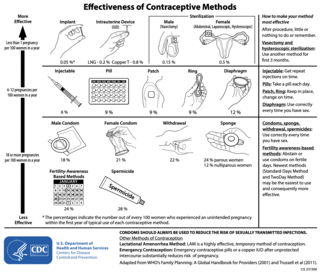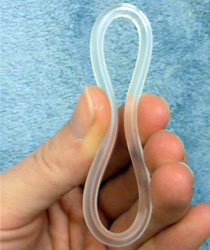
Emergency contraception (EC) is a birth control measure, used after sexual intercourse to prevent pregnancy.

The combined oral contraceptive pill (COCP), often referred to as the birth control pill or colloquially as "the pill", is a type of birth control that is designed to be taken orally by women. The pill contains two important hormones: a progestin and estrogen. When taken correctly, it alters the menstrual cycle to eliminate ovulation and prevent pregnancy.

Gregory Goodwin Pincus was an American biologist and researcher who co-invented the combined oral contraceptive pill.

A progestogen, also referred to as a progestagen, gestagen, or gestogen, is a type of medication which produces effects similar to those of the natural female sex hormone progesterone in the body. A progestin is a synthetic progestogen. Progestogens are used most commonly in hormonal birth control and menopausal hormone therapy. They can also be used in the treatment of gynecological conditions, to support fertility and pregnancy, to lower sex hormone levels for various purposes, and for other indications. Progestogens are used alone or in combination with estrogens. They are available in a wide variety of formulations and for use by many different routes of administration. Examples of progestogens include natural or bioidentical progesterone as well as progestins such as medroxyprogesterone acetate and norethisterone.

Levonorgestrel is a hormonal medication which is used in a number of birth control methods. It is combined with an estrogen to make combination birth control pills. As an emergency birth control, sold under the brand names Plan B One-Step and Julie, among others, it is useful within 72 hours of unprotected sex. The more time that has passed since sex, the less effective the medication becomes, and it does not work after pregnancy (implantation) has occurred. Levonorgestrel works by preventing ovulation or fertilization from occurring. It decreases the chances of pregnancy by 57 to 93%. In an intrauterine device (IUD), such as Mirena among others, it is effective for the long-term prevention of pregnancy. A levonorgestrel-releasing implant is also available in some countries.
Progestogen-only pills or progestin-only pills (POP) are contraceptive pills that contain only synthetic progestogens (progestins) and do not also contain estrogens. They are colloquially known as mini pills.

Edris Roushan Rice-Wray, was a pioneer in medical research who helped to prove the worth of the oral contraceptive pill. Her work on the birth control injection pill is especially notable as medical research was influential in the creation of the birth control pill. Rice-Way headed a large scale, clinical trial of the first birth control pill in the late 1950s in Puerto Rico.
Clarence James Gamble, was an American medical doctor and the heir of the Procter and Gamble soap company fortune. He was an advocate of birth control and eugenics, and founded Pathfinder International.

Hormonal contraception refers to birth control methods that act on the endocrine system. Almost all methods are composed of steroid hormones, although in India one selective estrogen receptor modulator is marketed as a contraceptive. The original hormonal method—the combined oral contraceptive pill—was first marketed as a contraceptive in 1960. In the ensuing decades many other delivery methods have been developed, although the oral and injectable methods are by far the most popular. Hormonal contraception is highly effective: when taken on the prescribed schedule, users of steroid hormone methods experience pregnancy rates of less than 1% per year. Perfect-use pregnancy rates for most hormonal contraceptives are usually around the 0.3% rate or less. Currently available methods can only be used by women; the development of a male hormonal contraceptive is an active research area.

There are many methods of birth control that vary in requirements, side effects, and effectiveness. As the technology, education, and awareness about contraception has evolved, new contraception methods have been theorized and put in application. Although no method of birth control is ideal for every user, some methods remain more effective, affordable or intrusive than others. Outlined here are the different types of barrier methods, hormonal methods, various methods including spermicides, emergency contraceptives, and surgical methods and a comparison between them.
Mestranol/norethynodrel was the first combined oral contraceptive pill (COCP) being mestranol and norethynodrel. It sold as Enovid in the United States and as Enavid in the United Kingdom. Developed by Gregory Pincus at G. D. Searle & Company, it was first approved on June 10, 1957, by the U.S. Food and Drug Administration for treatment of menstrual disorders. The FDA approved an additional indication for use as a contraceptive on June 23, 1960, though it only became legally prescribable nationwide and regardless of the woman's marital status after Eisenstadt v. Baird in 1972. In 1961, it was approved as a contraceptive in the UK and in Canada.

Birth control, also known as contraception, anticonception, and fertility control, is the use of methods or devices to prevent unintended pregnancy. Birth control has been used since ancient times, but effective and safe methods of birth control only became available in the 20th century. Planning, making available, and using human birth control is called family planning. Some cultures limit or discourage access to birth control because they consider it to be morally, religiously, or politically undesirable.
John Charles Rock was an American obstetrician and gynecologist. He is best known for the major role he played in the development of the first birth control pill, colloquially called "the pill".

The birth control movement in the United States was a social reform campaign beginning in 1914 that aimed to increase the availability of contraception in the U.S. through education and legalization. The movement began in 1914 when a group of political radicals in New York City, led by Emma Goldman, Mary Dennett, and Margaret Sanger, became concerned about the hardships that childbirth and self-induced abortions brought to low-income women. Since contraception was considered to be obscene at the time, the activists targeted the Comstock laws, which prohibited distribution of any "obscene, lewd, and/or lascivious" materials through the mail. Hoping to provoke a favorable legal decision, Sanger deliberately broke the law by distributing The Woman Rebel, a newsletter containing a discussion of contraception. In 1916, Sanger opened the first birth control clinic in the United States, but the clinic was immediately shut down by police, and Sanger was sentenced to 30 days in jail.

Birth control in the United States is available in many forms. Some of the forms available at drugstores and some retail stores are male condoms, female condoms, sponges, spermicides, and over-the-counter emergency contraception. Forms available at pharmacies with a doctor's prescription or at doctor's offices are oral contraceptive pills, patches, vaginal rings, diaphragms, shots/injections, cervical caps, implantable rods, and intrauterine devices (IUDs). Sterilization procedures, including tubal ligations and vasectomies, are also performed.

Progesterone (P4) is a medication and naturally occurring steroid hormone. It is a progestogen and is used in combination with estrogens mainly in hormone therapy for menopausal symptoms and low sex hormone levels in women. It is also used in women to support pregnancy and fertility and to treat gynecological disorders. Progesterone can be taken by mouth, vaginally, and by injection into muscle or fat, among other routes. A progesterone vaginal ring and progesterone intrauterine device used for birth control also exist in some areas of the world.

Combined hormonal contraception (CHC), or combined birth control, is a form of hormonal contraception which combines both an estrogen and a progestogen in varying formulations.
Sterilization of Latinas has been practiced in the United States on women of different Latin American identities, including those from Puerto Rico and Mexico. There is a significant history of such sterilization practices being conducted involuntarily, in a coerced or forced manner, as well as in more subtle forms such as that of constrained choice. Forced sterilization was permissible by multiple states throughout various periods in the 20th century. Issues of state sterilization have persisted as recently as September 2020. Some sources credit the practice to theories of racial eugenics.
Celso-Ramón García was an American physician who specialized in reproductive endocrinology and infertility. He oversaw early clinical trials of the first oral contraceptive pill in Puerto Rican women and later became a professor of human reproduction at the University of Pennsylvania.
Fertility while breastfeeding is controlled by the hormonal effects induced by breastfeeding during the postpartum period. Hormones associated with lactation and breastfeeding can inhibit processes necessary for conception. Because of the high variation of this process, breastfeeding is not recommended to be a method of contraception by medical providers, although correct use of breastfeeding as contraception, termed Lactational Amenorrhea Method (LAM), is as effective as hormonal contraceptive pills for the first six months after birth.













